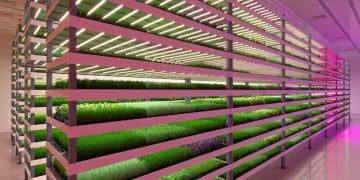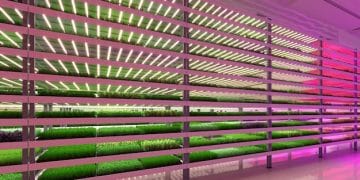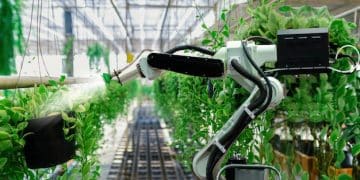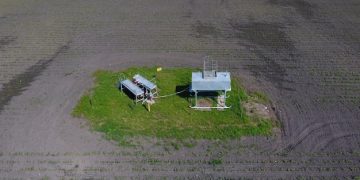Vertical Farming in the US: Tripling Yields with CEA
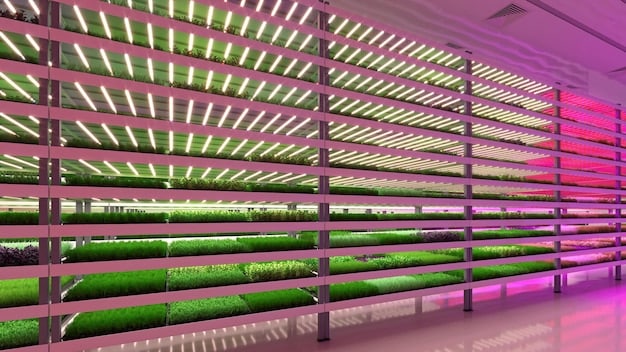
Vertical farming in the US utilizes controlled environment agriculture (CEA) to achieve up to three times higher yields compared to traditional farming methods, optimizing resource use and crop production in urban and peri-urban areas.
Discover how vertical farming in the US: achieving 3x higher yields with controlled environment agriculture is revolutionizing food production, offering sustainable solutions to meet growing demands and minimize environmental impact.
What is Vertical Farming and Why is it Gaining Traction in the US?
Vertical farming is an innovative agricultural practice that involves growing crops in vertically stacked layers, often indoors. This method maximizes space and optimizes growing conditions through controlled environment agriculture (CEA). In the US, vertical farming is gaining traction due to its potential to address food security challenges, reduce the environmental impact of agriculture, and provide fresh produce in urban areas.
Benefits of Vertical Farming
Vertical farming presents several advantages over traditional agricultural methods. These benefits contribute to its growing popularity and adoption in the US.
- Higher Yields: Vertical farms can produce significantly more crops per square foot compared to conventional farms.
- Resource Efficiency: These farms use less water and reduce the need for pesticides and herbicides.
- Year-Round Production: Controlled environments allow for continuous crop cycles, regardless of external weather conditions.
The controlled environment in vertical farms can lead to more consistent and predictable yields, minimizing the risks associated with climate change and seasonal variations.
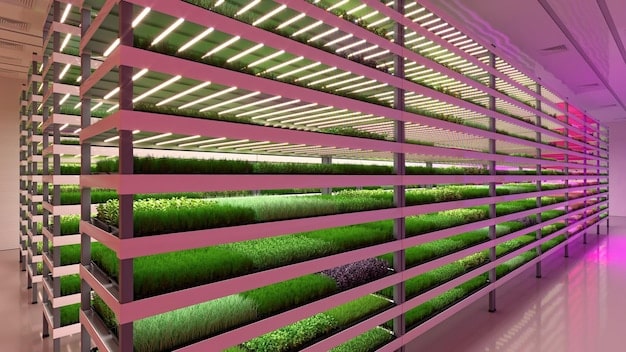
How Controlled Environment Agriculture (CEA) Works in Vertical Farms
Controlled environment agriculture (CEA) is at the heart of vertical farming. CEA involves manipulating environmental factors such as temperature, humidity, light, and nutrient levels to create optimal growing conditions. This precise control allows vertical farms to maximize crop yields and quality.
Key Components of CEA in Vertical Farms
CEA systems in vertical farms typically include several key components that work together to create the ideal environment for plant growth.
- Lighting Systems: LED lights are commonly used to provide plants with the specific wavelengths of light they need for photosynthesis.
- Climate Control: Systems regulate temperature and humidity to prevent disease and ensure optimal growth.
- Nutrient Delivery: Hydroponic, aeroponic, or aquaponic systems deliver nutrients directly to the plant roots.
The use of CEA allows for a highly efficient and sustainable approach to agriculture, reducing waste and maximizing productivity.
Achieving 3x Higher Yields: The Science Behind Vertical Farming Success
One of the most compelling benefits of vertical farming in the US: achieving 3x higher yields with controlled environment agriculture is its ability to produce significantly higher yields than traditional farming. This is achieved through a combination of optimized growing conditions and efficient resource management.
Optimized Growing Conditions
By controlling environmental factors, vertical farms can create the perfect conditions for plant growth, leading to higher yields and faster crop cycles.
For instance, the ability to precisely control the light spectrum can enhance photosynthesis, while maintaining optimal temperatures and humidity levels can minimize stress on plants, promoting healthy growth.
Efficient Resource Management
Vertical farms also excel in resource management, particularly in water and nutrient usage. Hydroponic and aeroponic systems recycle water and nutrients, reducing waste and minimizing environmental impact.
Moreover, the closed-loop systems used in vertical farms prevent nutrient runoff, which can pollute waterways and harm aquatic ecosystems.

The Economic Impact of Vertical Farming in the US
The economic impact of vertical farming in the US extends beyond increased crop yields. It includes job creation, reduced transportation costs, and the potential to revitalize urban areas. As the industry grows, it is expected to contribute significantly to the US economy.
Job Creation and Urban Revitalization
Vertical farms create jobs in various sectors, including agriculture, technology, and logistics. These jobs often provide opportunities for residents in urban areas, contributing to economic revitalization.
Additionally, vertical farms can transform abandoned or underutilized buildings into productive agricultural spaces, improving the aesthetic appeal and economic viability of urban neighborhoods.
Reduced Transportation Costs
By locating farms closer to consumers, vertical farming reduces the need for long-distance transportation of produce. This not only lowers transportation costs but also reduces the carbon footprint associated with shipping food.
The ability to grow crops locally ensures that consumers have access to fresh, locally grown produce, supporting local economies and reducing reliance on imported goods.
Challenges and Obstacles Facing Vertical Farming in the US
Despite its many benefits, vertical farming in the US faces several challenges and obstacles. These include high initial investment costs, energy consumption, and the need for skilled labor. Overcoming these challenges is crucial for the sustainable growth of the industry.
High Initial Investment Costs
The initial investment required to set up a vertical farm can be substantial. This includes the cost of building or retrofitting a facility, installing lighting and climate control systems, and setting up nutrient delivery systems.
Government incentives, private investments, and technological advancements are needed to lower the barriers to entry and make vertical farming more accessible to entrepreneurs and farmers.
Energy Consumption
Vertical farms can be energy-intensive, particularly due to the need for artificial lighting and climate control systems. However, advancements in LED technology and renewable energy sources are helping to reduce energy consumption.
Implementing energy-efficient practices and investing in renewable energy infrastructure can make vertical farming more sustainable and environmentally friendly.
The Future of Vertical Farming: Trends and Innovations to Watch
The future of vertical farming is bright, with numerous trends and innovations poised to transform the industry. These include advancements in automation, AI-driven optimization, and the development of new crop varieties specifically suited for vertical farming environments.
Advancements in Automation
Automation is playing an increasingly important role in vertical farming. Automated systems can handle tasks such as planting, harvesting, and monitoring plant health, reducing labor costs and increasing efficiency.
Robotics and other automation technologies are helping to streamline operations and optimize resource usage, making vertical farms more productive and cost-effective.
AI-Driven Optimization
Artificial intelligence (AI) is being used to optimize growing conditions in vertical farms. AI algorithms can analyze data from sensors and adjust environmental factors to maximize crop yields and quality.
AI-driven systems can also predict potential problems, such as disease outbreaks, allowing farmers to take preventative measures and minimize losses.
| Key Aspect | Brief Description |
|---|---|
| 🌱 Higher Yields | Vertical farms achieve up to 3x higher yields compared to traditional farming. |
| 💡 CEA Benefits | Controlled environment agriculture optimizes growth conditions for maximum efficiency. |
| 🏙️ Urban Farming | Vertical farms provide fresh produce in urban areas, reducing transportation costs. |
| 🤖 Automation | Automation and AI further enhance efficiency and reduce labor costs. |
FAQs About Vertical Farming
▼
The primary advantage of vertical farming is its ability to produce significantly higher crop yields in a smaller area compared to traditional farming methods, optimizing space and resources.
▼
CEA improves crop yields by precisely controlling environmental factors like temperature, humidity, and light, creating optimal growing conditions that maximize plant growth and minimize stress.
▼
Leafy greens, herbs, and certain fruits like strawberries and tomatoes are well-suited for vertical farming due to their compact size, rapid growth cycles, and high market demand in urban areas.
▼
The main challenges include high initial investment costs, energy consumption, and the need for skilled labor to manage complex technological systems, requiring innovation and investment to overcome.
▼
Vertical farming promotes sustainability by reducing water usage, minimizing the need for pesticides, cutting transportation emissions, and enabling local food production, supporting environmental preservation.
Conclusion
Vertical farming in the US: achieving 3x higher yields with controlled environment agriculture represents a significant advancement in agricultural technology, offering sustainable and efficient solutions to meet the growing demand for food. While challenges remain, the potential benefits of vertical farming are immense, positioning it as a key component of the future of agriculture in the United States.

